What is Dog Body Language?

Our canine friends have an intricate language of nonverbal communication known as body language.
Body language is the way a dog uses his or her body to communicate their emotions, state of mind, as well as their intentions with dogs, humans, and other species. Observing their movements and postures can help us know when they are happy, excited, fearful, conflicted, confident, or nervous.
Body language is a combination of movement, posture, and facial expressions.
Movement includes tail wagging, ears forward/backward, the head tilting up/down. Moving towards you or something they want to engage with when they want something like attention, food, or to initiate play. Moving away from you or a stimulus when they feel uncomfortable, threatened, or scared.
Posture
The way the dog carries and holds their body can tell you a whole lot about how they are feeling. A relaxed/ ‘loose’ posture can indicate that they are happy, while a stiff and tense/ alert posture can indicate fear or aggression. Postures include laying down, sitting up, or standing straight with stiff legs (fixed position), or standing relaxed and ‘loose’ (clam position), bending over, or leaning backwards/ away to avoid something.
Facial expressions
These are also used to communicate with other dogs and humans. These include soft eyes to indicate the dog is feeling safe and relaxed, or hard eyes accompanied by a furrowed or raised brows, which can indicate discomfort or fear. Facial expressions also include showing teeth if anxious about something happening around him/her; yawning when stressed, tired, or bored; licking their lips or nose to show calming signals/ appeasement gestures when nervous or scared; lowering head if upset or unsure; rolling eyes back down into the head if the dog is uncomfortable and threatened.
What does the dog use to communicate?
– Their eyes
– Ears
– Tail
– Teeth
– Legs
– Mouth
– Their back (spine)
– Movement and space
We can learn a lot about what our dogs are ‘thinking’ by taking the time to look and observe their body cues. By learning how to interpret them properly, we can better understand how our dogs feel, what they need from us, and how best to work with them.
Importance of observations
Interpreting the dog’s body language should be done in relation to the surroundings as it can be interpreted in a different manner depending on what else is going on. For example, in a familiar or familiar-feeling setting, the dog looks friendly or excited when the dog is wagging their tail in ‘loose’ circular motions, but if the dog is feeling uncertain, wary, or threatened, then their tail may be wagging in a low or in a straight stiffed like motion.
It is very important to not over analyze and interpret any one individual signal or posture on its own. You need to look at the dog’s entire body, demeanour, posture, and most importantly, consider the environment and environmental stimuli.
Here are examples of the three most commonly used body language signals:
“I want to play with you.”

— Dipped shoulders, head to one side, and a bouncy sort of reversed bunny hop, which is important as it emits a clear signal to the other dog that the dog is not a threat and there’s potential for them to become buddies.
“Oh no, I’m not sure what to do?”

— Head turns away, showing avoidance and defusing a tense situation. Ears are down and the mouth may be closed or offering lip-licking behaviours. The body’s still and the tail may be low and have a faint wag.
“Back off!”

— The body appears stiff and rigid, the shoulders set, and the eye contact becomes fixed all signaling to the other dog it doesn’t want to mingle, so keep your distance.
Types of body language
Calming signals
The dog uses subtle cues and body language to avoid conflict and prevent aggressive encounters. It is also used as a form of self-soothing – to calm oneself down as well as to calm other dogs down.

Yawning (when the dog is not tired)
Sometimes dogs yawn to release tension, avoid conflict, or to indicate they need a break.
The dog is unsure of the trigger approaching.
They are feeling stressed, uneasy, worried, or fearful.
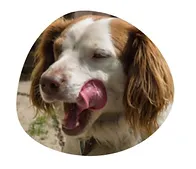
Lip or nose licking (when there is no food involved)The stimulus/trigger could be too close, and this behaviour and action can indicate the dog is uncomfortable, worried, or stressed. It is an appeasement or submissive gesture to avoid and prevent aggression from escalating.
It can also be used to soothe another animal or person the dog feels threatened by showing a non-threatening gesture.
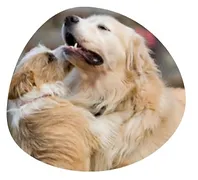
Turning away/ head turns (avoidance behaviour)
The dog is showing a non-threatening posture and avoiding confrontation.
Avoidance behaviour helps to de-escalate a potentially tense situation.
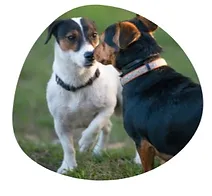
Freeze or paw lift.
Indicates that the dog is uncomfortable and stressed.
This gesture is also a form of a calming signal, however, should not be misinterpreted if the dog is a hunting breed, which is part of an instinctual hunting sequence to point out potential prey. That would be a completely different context to the behaviour. Depending on the context and environment, a freeze/ paw lift is generally used when the dog is feeling overwhelmed, anxious, conflicted, or anticipating something.
Stress signals
When considering canine body language, the first thing to understand is the CONTEXT in which the behaviour is displayed.
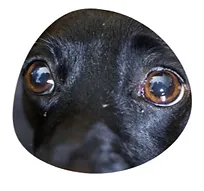
Dilated pupils.
Large pupils. Sign of fear or arousal. This can indicate the dog is stressed, threatened, or excited.

Mouth shut & ears back.
Nervous response, unsure of what’s happening and appearing non-threatening.

Food avoidance (when the dog is not unwell)
Stress suppresses appetite. The dog could be overwhelmed and unable to process food at that moment in time. Not taking food when the dog is normally greedy can be an indication of stress, or the dog could be overly excited (aroused) and can not take food at that time.

Whale eye.
Eyes wide open. Large pupils and whites of the eye is visible. The dog is feeling extremely uncomfortable or threatened.
Calming and stress signals.
The dog uses subtle cues and body language to avoid conflict and prevent aggressive encounters. It is also used as a form of self-soothing to calm oneself down and to calm the other dog/ human down.
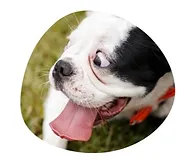
Spatula tongue.
The shaping of the tongue occurs when the dog has been panting, most likely due to intensive exercise, over arousal, or it can be an indication of stress.
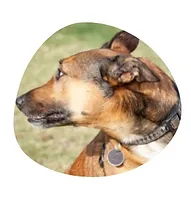
Avoidance
Non-engaging behaviour. Completely avoiding the threat.

Tail Tucked
Protecting genitals. Signal of submission and fear. It is a clear signal the dog is afraid.

Ears pinned back.
The dog could be unsure and feel conflicted.
Fearful and timid reaction to a threat.
Aggression
These are clear body language signals indicating the dog is uncomfortable and intends to bite and attack if the perceived threat continues.
These behaviours include hard stare from the eyes (no blinking), growling, barking, lunging, snarling, snapping, and biting.
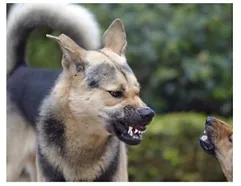
Offensive aggression
Very dangerous and aggressive. The dog means business and has the intent to bite. Usually accompanied by stiff body language, baring teeth, tail will be rigid (held high or tucked), growling, lunging out snapping, snarling, and excessively lip licking.
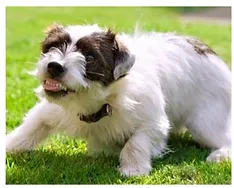
Defensive (Agnostic aggression)
This indicates that the dog is frightened, feels threatened, and will attack to protect itself as last resort.
Weight is distributed to the hindquarters, snarling, growling, baring teeth, sneezing, and lip licking.
Conclusion
Dogs do not always show vocalizations or other outward behaviours like lunging out and barking when over threshold, some become quiet and subdued. Some show little behaviour cues or signals and freeze/ shutting down going into a state of learned helplessness (a psychological state where an animal ‘gives up’).
Iability to eat or take a treat when they are usually quite greedy. This big indicator that your dog is not coping and changing the environment for your dog to help them feel safe and comfortable will most likely relieve the dog enough to take the treat again.
Understanding how your dog ‘speaks’ keeps both of you safe, and can help build a better bond between you and your dog.
It may feel overwhelming at the beginning when you are trying to interpret dog body language, but be patient – practice makes perfect. Always remember never to read one cue/ signal on its own, and always take your environment and situation into account so you can interpret the right context in which your dog is communicating.
References:
Rugaas, Turid. On Talking Terms with Dogs: Calming Signals. Dogwise Publishing, 1997.
Signs Your Dog is Stressed and How to Relive It. VCA Animal Hospitals.
Amy L. Pike, DVM, DACVB, Canine Body Language Basics, https://www.dvm360.com/view/canine-body-language-basics American Veterinarian, Feb 2018, Vol 3, Issue 2
Tags
What do you think?
Related Articles
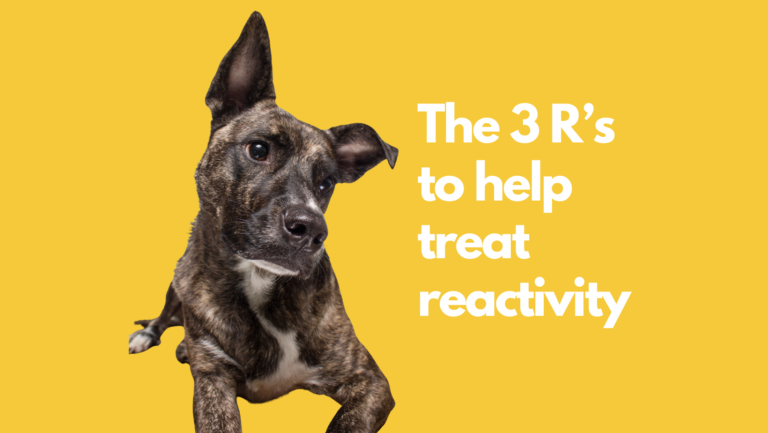
The 3 R’s to help treat reactivity
Training your dog is not just about teaching them to listen and ‘fixing’ unwanted behaviours; it’s about creating positive associations with their environment and building
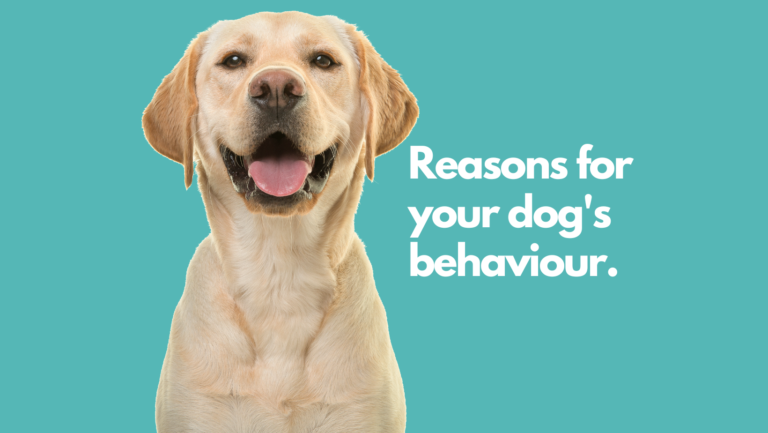
Reasons for a dogs behaviour
Dogs behave the way they do for many reasons. They do NOT do things deliberately to be stubborn or ‘naughty’, nor do they aim to

New Puppy Daily Routine Guide
The excitement of bringing a new puppy home can be overwhelming and scary at the same time. There are so many things to think about
